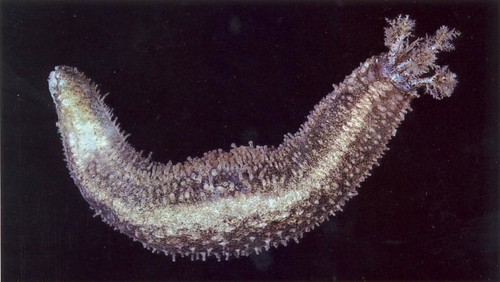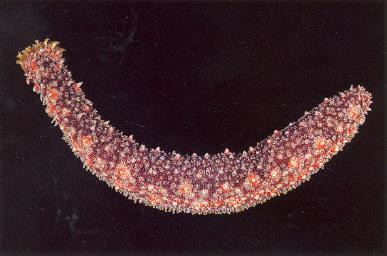There is a real.. peace from watching them. Slow. Confident. Unworried. Sea pigs and other sea cucumbers... all with their benthic detrital serenity. Its soothing really.
Today: a little gallery showing some nice closeups to ease that tired day today!
Sea cucumbers are versatile creatures. Some species can actually feed with filter feeding apparatus inside their anus (shown below). If you're not feeding from the front there's always the other end...
Here's the business end: the mouth on some glass, picking tiny detrital food off the surface. Although "scavenger" and "detritivore" doesn't sound very glamorous, it turns out that this serves a vital function to ecosystems in both shallow and deep-sea ecosystems (see the secrets of sea cucumber poop here! ) Sediment is aerated and "turned over" and doesn't just build up anoxic organics... etc.
here is where it all starts!

Some nice video of a Japanese species showing aforementioned feeding tentacles which are used to pick food off the substratum
Today: a little gallery showing some nice closeups to ease that tired day today!
Sea cucumbers are versatile creatures. Some species can actually feed with filter feeding apparatus inside their anus (shown below). If you're not feeding from the front there's always the other end...
Here's the business end: the mouth on some glass, picking tiny detrital food off the surface. Although "scavenger" and "detritivore" doesn't sound very glamorous, it turns out that this serves a vital function to ecosystems in both shallow and deep-sea ecosystems (see the secrets of sea cucumber poop here! ) Sediment is aerated and "turned over" and doesn't just build up anoxic organics... etc.
here is where it all starts!

Some nice video of a Japanese species showing aforementioned feeding tentacles which are used to pick food off the substratum
Several more species with their feathery feeding arms extended..
Here's a nice one showing one of the feeding arms with food being moved INTO the mouth...
and here...

and let us end with one of the most beautifully shot sea cucumber feeding videos!! Taken by "liquidguru"!
Lembeh Magnum Sea Cucumber from liquidguru on Vimeo.











